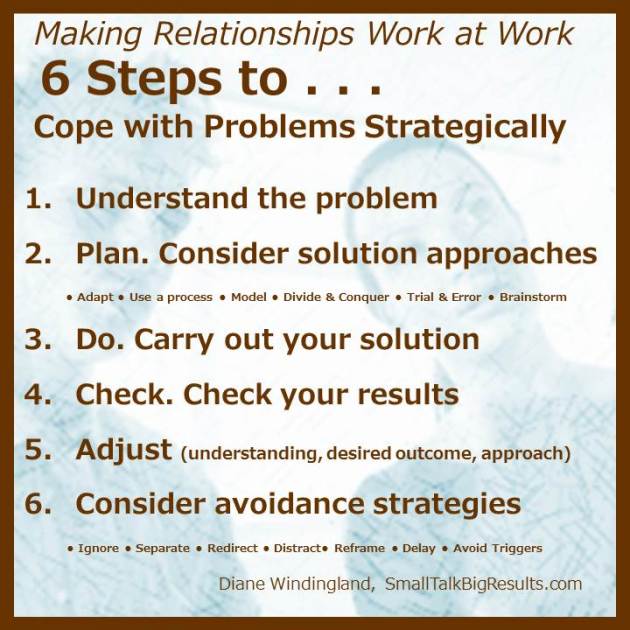Cope with Work Relationship Problems Strategically
July 24, 2013 2 Comments
Aside from sleep, work takes up most of our time. And, the most challenging aspects of work are often the clashes with coworkers, clients, management or employees.
Learning how to cope with work relationship problems strategically will reduce your stress and make your job easier.
Psychologists say you can cope by solving a problem (problem-focused coping), or you can cope by avoiding a problem (emotion-focused coping). Ideally, solving a problem would permanently remove the stress, but as some problems are not easily solved, avoiding the problem also will result in stress reduction. Often, you can engage in problem avoidance strategies while simultaneously working on solutions.
The steps are outlined below:
1. Understand the problem and determine the desired outcome. Maybe this is obvious, but don’t make assumptions about the problem and don’t try to solve a problem without knowing what you want as an outcome. Let’s take the problem of an employee who habitually comes in late as an example. You could assume that the employee is late because of poor planning or a lackadaisical attitude, and deal with the problem punitively, or you could find out why the employee is late (maybe their childcare provider is habitually late) and help them explore solutions, while setting clear expectations.
2. Plan. Consider solution approaches.
- Adapt a solution from a similar situation—consider using solutions that have worked in similar situations. Have you had other employees come in late? What have you done? If you don’t have a highly similar situation, consider a similar situation, maybe even from your personal life. If your teenager is late for school, how do you cope with that?
- Use a Process. Some relationship problems occur regularly. Have a proven process in place, and maybe even a script. Once you have had a problem, take notes! When it happens again, review the notes and develop a process. If you work for a large company, your HR department may already have processes in place. Having a process in place encourages consistency and fairness, and saves you the time you might agonize over what to do.
- Model the problem with role-playing. Practice your solution. At the very least, do a dry-run in your head. Better yet, practice with someone else.
- Divide and conquer. Break down a big, complex problem into smaller, more easily solvable problems. Perhaps there are multiple problems that contribute to the problem of being late. Consider addressing the smaller problems first.
- Use Trial-and-Error. Trial-and-Error can be preferable to doing nothing, if the steps are small and without grave consequences. In the case of the late employee, you can start with simply asking the employee to come in on time and telling the employee why it’s important (to both the company and the employee). If that does not yield the desired results, you can try having a problem-solving discussion, perhaps using a “divide and conquer” approach. Then, if lateness is still an issue, you can try something else, like a written agreement, spelling out expectations and consequences for not meeting the expectations.
- Brainstorm: You can do this alone, but you can also do it with another person, or in a group, if the issue is not confidential. Brainstorming a large number of solutions (let the Post-It Notes fly!) and then reduce the number of solutions by using the above methods.
3. Do. Carry out your solution plan.
4. Check. Check your results.
5. Adjust. If the outcome is not achieved, consider adjusting your understanding, your desired outcome and your solution approach.
6. Consider problem avoidance strategies. A few avoidance strategies:
- Ignore. Some problems, especially if they are minor and not likely to recur aren’t worth the energy to solve, or to even avoid. (e.g. someone is late to work because they were in a car accident).
- Separate. Physically separate the problem or conflict-inducing entities. Move seats. Adjust schedules.
- Redirect. Change the subject to one on which there is agreement.
- Distract. Distract yourself or the other person with something more engaging, preferably something that is fun, relaxing or mentally stimulating in a way that is very different than the problem at hand. Give yourself a “time-out” from the problem by going to the employee lounge, listening to music, or switching to a task that you are excited about.
- Reframe. Look at the problem another way. Consider the significance to the “big picture” or to a longer timeline. Ask yourself, “will this matter in 5 years?” Consider how the problem might look from another individuals point of view. Or, better yet, ask yourself, “what is the opportunity in this problem?” An employee’s poor communication skills become an opportunity for learning. Loss of a major client becomes an opportunity to grow existing clients and find new, possibly better clients.
- Delay. Put it off until “later.” Agree to address the problem at a later time, if putting it off won’t have dire consequences.
- Avoid Triggers. With experience, you will learn that certain things may trigger or escalate a problem. It’s often easy to see what triggers other people, but you have your own triggers, too. For example, when people are late for an appointment with me, I find that somewhat irritating. I used to find it extremely irritating. I have avoided triggering my anger response by modifying my own behavior. I have a plan in place. First, I almost always confirm appointments the day before with an email. Second, if someone is more than 10 minutes late, I call them and ask if they are on their way (which means that I have taken the time to make sure I have their cell phone number). Third, if I end up waiting, I always have something to do, rather than fume (with a smart phone, this is easy—email, Facebook, Kindle Reader and more are available). Finally, if necessary, I will reschedule.
Do you have any additional coping strategies for solving, or temporarily avoiding problems?
This post is 5th in the series 7 Principles of Making Relationships Work at Work.



Pingback: Pay Check
Good information. Lucky me I came across your
site by chance (stumbleupon). I’ve bookmarked it for later!